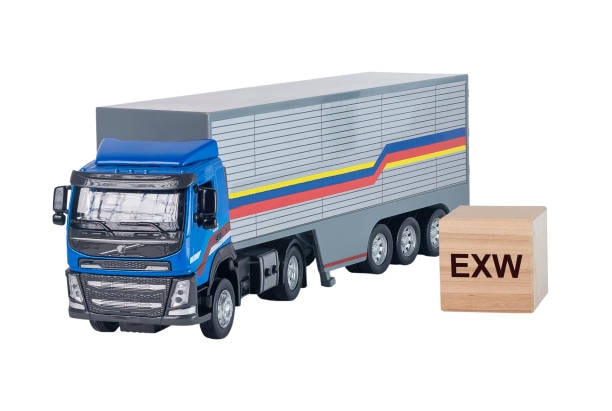International trade overviews EXW (Ex Works) shipping provisions which define how buyers and sellers handle goods during shipment. The EXW shipping term features multiple important components which affect how goods move throughout the delivery process. All participants in international trade including buyers and sellers and freight forwarders need complete understanding of EXW shipping to maintain operational efficiency. The discussion below examines EXW shipping rules by explaining its meaning in detail and describing essential characteristics while examining its position relative to other commercial terms. You will gain complete knowledge regarding EXW shipping together with costs associated with its importance in international trade after proceeding through this content.
What is EXW Shipping?

Ex Works operates as an International Commercial Term that establishes buyer responsibility for shipping since this term removes the seller’s premises responsibility from shipping operations. EXW establishes legal obligations that conclude when sellers give the goods to pick up at their site or an agreed destination. Under the EXW transaction method sellers disclaim most shipping responsibilities because buyers maintain complete responsibility for choosing transport solutions and cost payment and assume all risks from the point of goods readiness for pickup.
Regarding “Ex Works” the buyer is responsible goods reach visibility for collection at seller’s business premises or alternative specified area often being a factory warehouse or office. Once goods become available the buyer takes full financial responsibility and bears all possible risks throughout their transport to the intended destination.
Key Features of EXW Shipping
- Seller’s Responsibility: In EXW terms the seller makes goods accessible for pickup but carries no further responsibility outside allowing the buyer to take possession at their designated spot. Sellers maintain no duty to transport the goods nor to load them onto vehicles according to this agreement. The buyer takes legal ownership of the goods at the moment they become reachable for their use.
- Buyer’s Responsibility: The buyer performs full responsibility for transportation starting from goods delivery up to final destination delivery.
- The buyer must retrieve the goods at their seller’s current location.
- The buyer must manage complete delivery operations from initial segregation to arranging shipping methods and subsequent distribution services.
- The buyer must pay all costs from transporting the goods including shipping fees together with customs levies and additional expenses for destination delivery.
- Risk and Insurance: Sole ownership of possible damage to the goods passes from sellers to buyers when goods reach their designated pick-up location. The buyer becomes responsible for securing insurance protection for transit goods following when they receive the merchandise because the seller loses responsibility for the transportation risks.
- Customs and Import Duties: Through EXW export terms the buyer assumes complete financial responsibility for all import duties alongside taxes needed for destination customs processing. When buyers lack experience with customs regulations between their country and the goods’ shipping origin it creates additional shipping complications.
- Minimal Seller Involvement: The seller takes minimal liability with EXW so it works well whenever suppliers avoid the costs of product transportation past their site boundaries. Big manufacturers and wholesale businesses frequently use EXW because of its minimal seller responsibilities.
EXW vs. Other Incoterms: A Comparison

The basic nature of shipping term EXW requires a thorough comprehension of its distinctions from other international commercial terms and Incoterms. During shipments Incoterms allocate clear responsibility zones to both sellers and buyers while establishing distinct contractual rules that apply to this process.
EXW vs. FOB (Free On Board)
EXW and FOB represent two widespread shipping terms yet they differ fundamentally in how they structure responsibility in the transportation and shipping process itself.
- Seller’s Responsibility: With EXW the seller must only provide the goods for pickup before termination of their responsibilities. When a seller uses FOB terms they must load the vessels at the port of shipment yet remain responsible for the goods.
- Risk Transfer: Buyers become fully responsible for product risks and liabilities when sellers present goods for pickup under EXW. The risk ownership shifts from seller to buyer through FOB when the shipper loads goods on their chosen vessel.
- Cost Implications: The buyer acquires higher shipping and costs obligations under EXW but sellers take the main responsibilities under FOB terms.

EXW vs. CIF (Cost, Insurance, and Freight)
The transaction conditions under CIF (Cost, Insurance and Freight) operate in fundamental differences from both the EXW incoterms and FOB Incoterms.
- Seller’s Responsibility: A seller who chooses CIF must take care of all purchase expenses including shipping costs along with insurance premiums from the moment products leave their control until they arrive at their destination port. With CIF the vendor incurs major transportation expenses starting from cost of goods and insurance all the way to the destination harbor point whereas EXW provides different conditions.
- Risk Transfer: The CIF contract format passes risk responsibilities to the buyer when the products reach vessel load status in a similar way FOB functions. The seller assumes financial responsibility for insurance charges while their products travel to their destination.
- Cost Implications: The CIF system eliminates shipping arrangement along with insurance costs for buyers because sellers cover all expenses from origin to destination port. This creates an easier purchase method suitable for non-professional shippers who are basically paying one price.

EXW vs. DDP (Delivered Duty Paid)
Under the Incoterms format DDP (Delivered Duty Paid) gives sellers broad responsibility thus making it the most advantageous term for them domestic market.
- Seller’s Responsibility: Using DDP in transactions means the seller will cover all costs from transporter to buyer door and handle customs clearance, taxes and duties buyer’s designated method.
- Risk Transfer: Under the EXW delivery method the seller has risk responsibility until product transportation ends at the buyer’s delivery site but under DDP the seller faces full risk until delivery fully completes actual fees.
- Cost Implications: Under a DDP arrangement sellers accept complete charges from taxes to duties to delivery costs to the buyer’s destination. In contrast, EXW shifts these burdens to the buyer.

Advantages of EXW Shipping
- Minimal Seller Responsibility: The EXW contract structure enables sellers to establish defined shipping limitations so they take minimum operational obligations. Under this agreement sellers maintain an easy transaction because their main duty centers on preparing goods for pickup by customers without taking on further responsibilities.
- Buyer’s Control Over Shipping: The familiarity of buyers with logistics methods leads them to choose EXW because this agreement ensures they gain complete autonomy over shipping coordination. When buyers maintain current freight forwarding relationships they gain benefits from selecting EXW to secure optimal transportation costs free alongside ship.
- Cost Savings for Sellers: When the buyer assumes transportation expenses EXW creates financial benefits for the seller. Through EXW the seller escapes both logistical shipping expenses as well as the management of shipping and handling needs export licenses.

Disadvantages of EXW Shipping
- Risk for the Buyer: A buyer receives full risk responsibility when they obtain their acquired goods. The buyer faces risks when they choose to assume all responsibility regarding pickup from an unknown seller or when faced with customs clearance problems or shipping challenges.
- Complex Logistics for the Buyer: EXW provides buyers with shipping control yet obligates them to handle all freight requirements even for complex international deliveries that often become demanding save money.
- Customs and Duty Issues: Buyers take responsibility to perform customs clearance duties while being obligated to pay taxes and duties when importing goods into their destination country ex works exw. The unpredicted expenses and delayed shipping times are most common when buyers lack knowledge about customs regulations in their area.
How to Manage EXW Shipping Efficiently
- Plan Ahead: The buyer has full responsibility for shipping under EXW therefore preparing in advance is essential. You must establish access to essential shipping resources through secure choices of freight forwarder and customs broker alongside shipping company.
- Know the Seller’s Location: Primary responsibility falls on the customer to ensure complete knowledge of the exact pickup point during transaction execution carriage paid. The basic understanding of the delivery location enables better planning of your transportation process free carrier.
- Understand Import Regulations: The buyer must handle customs clearance duties because knowing both the country of origin import rules and destination country regulations about import requirements remains essential to meet their obligations. Unnecessary delays and added expenses will result when businesses fail to meet customs requirements.
Conclusion
EXW provides a clear shipping solution for buyers who possess the capabilities to oversee their shipments independently. Under EXW the buyer must cover the expenses of shipping alongside all export customs clearance obligations while facing maximum uncertainty without proper shipping resources. Parties using EXW find benefits in decreased need for shipping management tasks and lower obligations for service delivery.
A proper understanding of EXW shipping terms export procedures becomes essential for all parties before entering an EXW agreement. Before entering into EXW agreements sellers need to understand specific limitations while buyers need full knowledge about handling shipping customs and duties. Higher efficiency combined with a better shipping experience becomes possible when both parties properly understand their requirements and risks and logistical needs.




